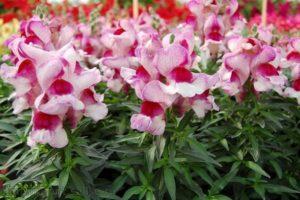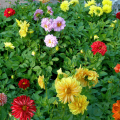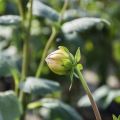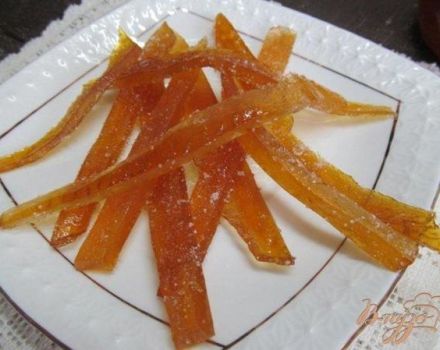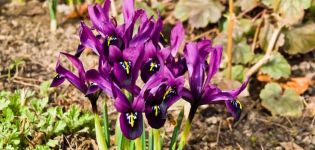Growing, planting and caring for dahlias in the open field
Professionals know a lot about dahlias, as well as the planting of these flowers and the conditions for caring for them in the open field. The nuances of planting relate to the choice of location (private plot, park, gardening) and the climatic zone. Flowers grow in cold climates (Siberia, Ural) and warm regions. Dahlias have a short growing season, this is an absolute plus, which allows them to be cultivated in various temperature conditions - from the Middle Zone of the Russian Federation to the Caucasus.
Description and characteristics of the flower
The plant belongs to the extensive family of Asteraceae or Compositae. The scientific name - Dahlia (Dahlia) - comes from the name of the famous Swedish botanist Anders Dahl. Dahlias cultivated in gardens and parks are nothing more than a cultural hybrid obtained after the painstaking work of enthusiasts, multiple interspecific crosses.
Wild plants grow in Central and South America, they are very different from their offspring. More than 15 thousand species of dahlias are known in the world. Groups of flowers (about 10) are formed according to characteristic features.
The plant is perennial. The roots form a tuber. The dahlia stem is even and straight, it rises to a height of 2 meters. Leaves with a dense structure, dark green (less often purple) shade. The flowering period of the plant falls on August-September, so dahlias are a frequent and welcome guest in autumn bouquets and compositions.
The inflorescence of dahlias is basket-shaped, the petals of the flower are like tongues. With the onset of frost, the plants are removed from the soil, the stems are separated from the tubers and stored in a cool dry place. There are also "annual" flowers - those that are grown from seeds. The division is conditional, since in the fall, dahlias form tubers, which serve for subsequent planting, plant reproduction.

Dahlia species
There are several tens of thousands of types of flowers, therefore, in order to somehow understand this variety, we decided to divide the plants into groups according to their appearance and characteristics. Botanists distinguish the following types of dahlias:
- Simple (non-double).
- Anemone-like.
- Collar.
- Peony.
- Decorative.
- Spherical.
- Pompom.
- Cactus.
- Semi-cactus.
- Nymphaean.
- Mixed.
In addition to these, there may be other varieties, since the family is very extensive, it is constantly replenished with new species.

Single row
Common (simple) cultivars known as Dahila Single. They are determined by tubular petals (of which there are more), and along the edge there is a series of false reed. They have well-known representatives that are popular - the Dutch Happy Kiss variety, with bright orange buds, large inflorescences measuring 100 millimeters. At the same time, the bushes in planting are small, no higher than half a meter.
Another characteristic specimen belonging to this species of dahlia is Romeo. It is deep red, up to 55 centimeters high, slightly darker in the center. Bronze-colored leaves.
Anemone
Introducing the following group of semi-double or anemone dahlias. In the inflorescence, 2 rows of reed petals are clearly distinguished. In color, there are both monochrome and with a contrasting colored middle. There are low and tall dahlias, respectively, the height ranges from 20 to 80 centimeters.
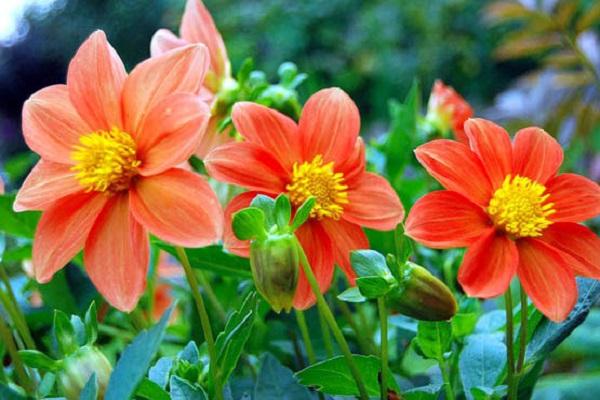
Cactus
These dahlias have inflorescences formed by numerous “needles” - tubular petals thinned at the end. In general, the flower resembles a cactus, hence the name. The color range is wide - from monochromatic to multi-colored lush double buds. The most common representatives of the species are Acapulco, Cherio, Lemon.
Semi-cactus
They are considered interspecies filling between cactus and decorative dahlias. The inflorescence of the plant is terry, with wide petals, which are folded at the base and form a characteristic tongue. Species - Mick's Peppermint, Aspen. Dahlias reach heights of up to 130 centimeters, bud size up to 200 millimeters.
Spherical
With this variety of dahlia, everything is relatively simple: the inflorescence forms the correct ball shape. The petals are wide, dense, wider at the end than at the base. The tips may be slightly rounded. The size of the "ball" is up to 200 millimeters. Famous representatives - Rocco, Noreen, Little Robert.
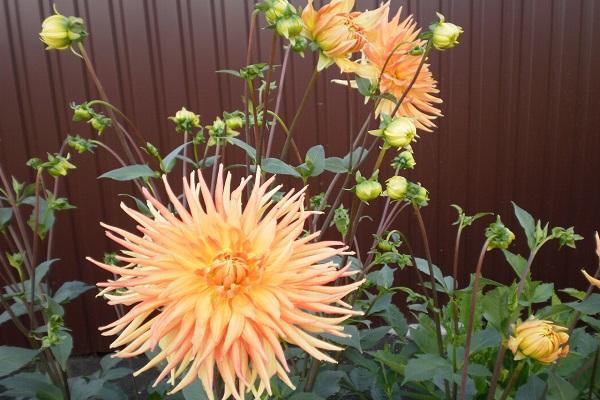
Nymph
The beautiful, delicately formed plants are terry plants and are similar to water lilies. The size of the bud is up to 200 millimeters, the height of the bush reaches 10 centimeters.
Pompom
The ball-shaped inflorescence resembles a lush pompom with petals rolled into a tube. Bud size - from 5 centimeters or more. Dahlia bushes are medium-sized, up to 120 centimeters high. Notable varieties are Hallmark (lavender), Willo's Violet (purple) and Noreen (pale pink).
Collar
The outer in-line petals form a characteristic “collar”, often adjoined by shorter and differently colored lobes. There are combinations of scarlet and yellow (La Gioconda), cream with gold (Claire de Luna) or red (Chimborazo). The size of the inflorescence of plants is up to 100 millimeters, with a plant height of about 120 centimeters.

Decorative
They differ in small, graceful inflorescences, although there are also large ones (up to 250 millimeters in diameter). Dahlia bushes are undersized, up to 60 centimeters. Common garden plots are David Howard orange, Thames Valley golden, Jocondo purple.
Mixed
An extensive group that unites plants that do not fit into the standard classification for some reason. It can be a color (black-red, almost uniform dark) or a shape. More often, some rare hybrids are mixed, in which breeders strive to combine many qualities. So, for many years, attempts to breed a blue dahlia remain unsuccessful.
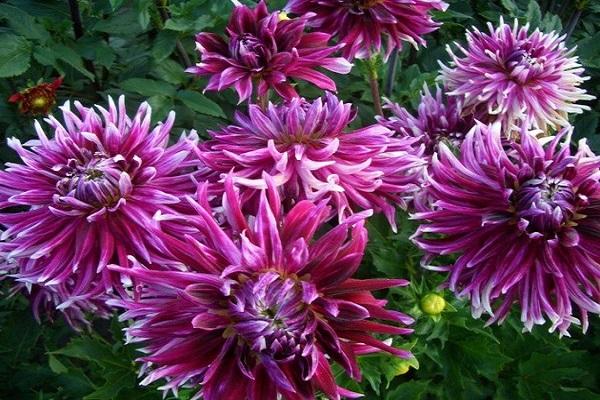
Reproduction
Having briefly studied the variety of plant varieties, gardeners begin to wonder quite reasonably - how can this miracle be propagated, what is necessary for planting. The options are the following - cuttings, tubers or seeds. Each of them has its own advantages, which will be discussed below.
By cuttings
The appearance of green cuttings in dahlias, which serve as the basis of the method, is preceded by the planting of tubers. The pre-prepared seed is placed in pots with a substrate and they begin to wait. After 14-21 days, the shoots should rise to a height of 80-100 millimeters, this is enough to get cuttings.
They work in 2 ways: by cutting out the stem at the base or breaking it out with a piece of tuber. Thick, strong stems are preferred - they have a higher chance of success. The cut is made immediately below the leaf node, about 3-5 millimeters from the petioles. If you work carefully, then there is enough material for both the petioles with a heel and for planting dahlia with tubers.
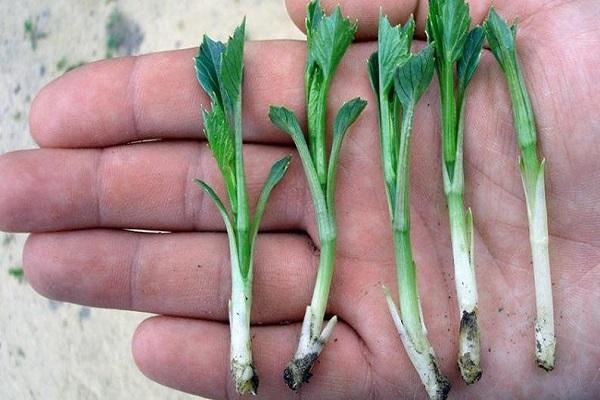
By dividing the tuber
To "save" on planting material, you should divide the dahlia tuber into several parts. It is desirable that a pair of kidneys remain on each segment (one is not enough, but it will also do). With weak buds, it is allowed to take a fragment of 2-3 articulated nodules. You can also divide the rhizome in half, observing the specified conditions. The knife must be cleaned and disinfected so as not to infect the plants.
Landing features
Growing healthy, beautiful flowers is difficult, but real. To do this, they are determined with the timing (spring, autumn), the method of planting and wait for the right moment. It is necessary to prepare the soil in advance, as well as supports - growing plants will need them. It does not hurt to worry about fertilizers, but only within reasonable limits. It is good if the future landing site is not in the shade - sunlight is important for dahlias.
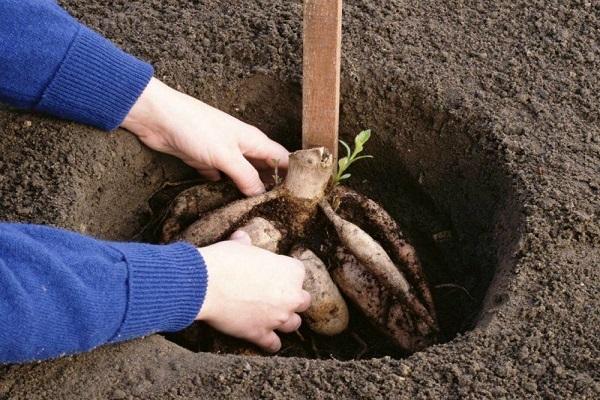
When to plant dahlias?
The specific planting time depends on the climatic conditions, the chosen method, the experience of the grower. In the spring, in the first or second decade of May, dahlias are planted by dividing the tubers, when the soil has already warmed up enough. Even earlier planting is allowed, but at the same time there is a risk of destroying the plant if it is not protected from frost.
In autumn, the matured bushes are prepared for wintering (if it is not planned to dig them up on the tubers). For this, hilling is carried out by 150-200 millimeters to protect against freezing. With a knowingly deep landing, there is no need for this procedure.
Preparation of planting material
To grow healthy and strong dahlias from seeds, you will need:
- Prepare a seed fund.
- Provide a fertilized, sufficiently loose soil.
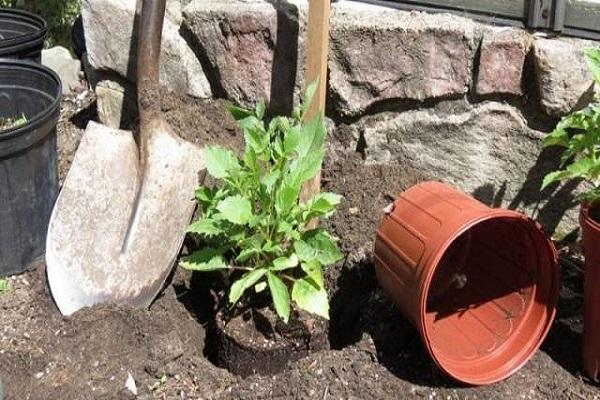
Dahlia seeds are large and easy to plant. You will need seed boxes or trays in which future garden beauties will have to grow. An earthen mixture is prepared from soil, humus (compost) and river sand. It is very important that the substrate is permeable to moisture and air, moderately loose. Preference is given to healthy, strong seeds, without traces of disease or pests.
Choosing a landing site
There are 2 options: planting in open ground or indoors, for seedlings. When planting in a row, the rule of an interval of 3-4 centimeters between seeds is observed. Shallow planted material is sprinkled with soil and covered with foil.
For dahlias, temperature and humidity conditions are important: heat - up to 25 degrees, with regular ventilation to avoid the occurrence of fungi. In a week, sprouts will appear as expected. Then the boxes are rearranged in a sunny place (the film is removed). For dahlias, planted immediately on a flower bed, choose a lighted, well-fertilized soil place. Land preparation can be done in advance, in the fall, in order to start planting in the spring.
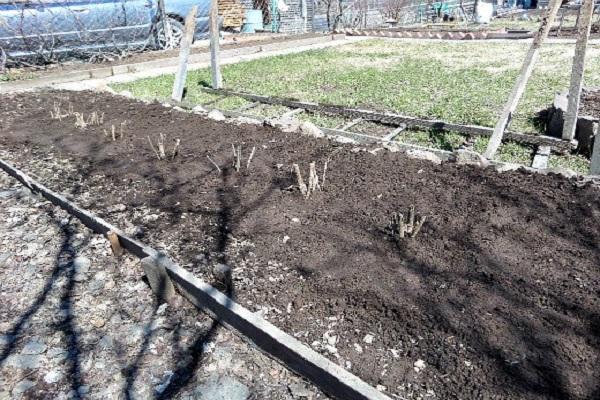
Open ground planting technology
Planting ready-made dahlia seedlings in open ground is not difficult if you follow certain recommendations. The soil should be fertile, the place should be lit and protected from drafts. Usually the transplant is done at the end of May, when it is already warm enough.
Dahlia seedlings are carefully transferred to the beds, trying not to damage the roots and stem, and immediately install supports for support (especially for tall varieties).With tuberous reproduction, the size of the fossa is chosen at the rate of exactly 3 times the underground part of the plant (approximately 40x40x40 centimeters). It remains to provide plants with feeding, care, and getting a beautiful flower garden is guaranteed.
Plant care
Dahlia's "maintenance" includes fertilization, support garters and pruning. This also includes watering (regular, but not excessive), loosening, weeding, and mulching.
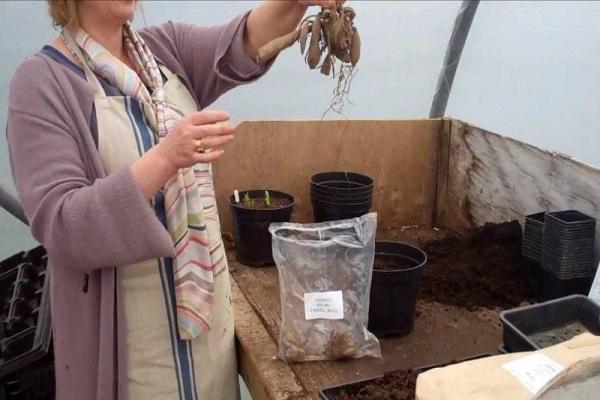
Fertilizer
During the growing season, dahlia is fed twice a month. Fertilizers - organics, minerals. They are brought in one by one, without mixing. Cow dung diluted with water works well (1 in 20). Ammonium nitrate is added at the rate of 15 grams per square meter. After the first buds are spiked on the plants, they switch to superphosphate, potassium complexes (aqueous solutions).
Support
Dahlias have fragile stems, so they need reliable support. These can be trellises, racks, pipes driven into the ground. Sometimes it is possible to save even a broken trunk by putting a splint on it from a twig or flat board. The plant treated in this way begins to bloom as if healthy.
Pruning
Dahlias are recommended to be pruned in order to properly form their crown, to manage plant growth. When grown from a tuber, a couple of shoots are usually left, removing the rest. With the cuttings, a single stem will suffice. Although sometimes, to make the dahlia bush look more presentable, they pinch the top, getting 2 stems.
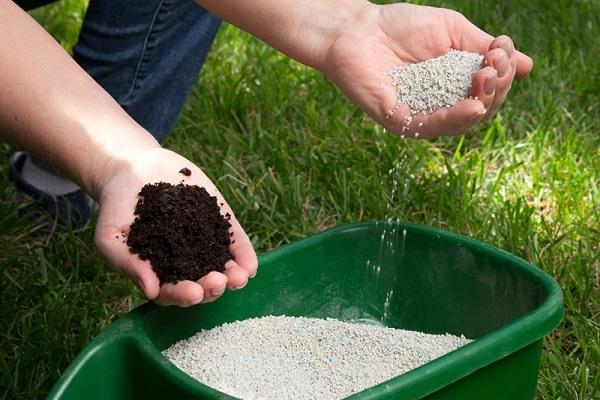
Large-flowered forms of the plant are processed differently: the side shoots growing from the axils (stepsons) are completely cut off. This is done so that the developing sprouts do not slow down the development of inflorescences, do not suppress the central trunk. Grasshopping is used regularly - as soon as the dahlias have been planted, and before the buds set.
Pests and diseases
Dahlias are susceptible to disease and can also be affected by pests, so gardeners must have information on how to deal with symptoms.
Spots on foliage are a consequence of insufficient ventilation, excessively frequent planting of bushes. They begin with yellowish-green formations, gradually turning into a brownish-gray tone. First, damaged areas are removed, and then you need to treat the bush with fungicides. In extreme cases, the dahlia bush will have to be destroyed so as not to harm the neighboring plants.

White rot (fungal form) affects growing and adult dahlias. The reason usually lies in the wrong choice of planting depth. It is treated with Fundazol, Gamair, and other preparations of the fungicidal group.
Plants are attacked by crawling and flying insects - caterpillars, butterflies. Both mechanical destruction of pests (with small volumes of damage) and treatment with insecticides are used.
Especially dangerous is the aphid that makes its colonies on many garden plants. The damaged leaves are cut off and burned, the remaining parts are sprayed with pesticides. Prevention will greatly facilitate pest and disease control. It includes regular examination, destruction of local lesions.
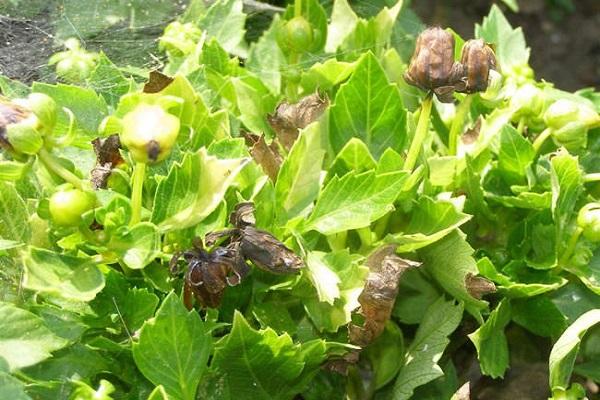
Digging up tubers
In autumn, perennial dahlias are dug up on tubers. They do this carefully so as not to damage the underground part. It is believed that a long stay in the soil (until the first frost) contributes to the formation and preservation of the tuber.
First, the stems of the plant are cut. This is done with a sharp knife or pruner, then the cut is closed to prevent contact with moisture. Before starting work, dahlia bushes must be identified; in the future, after cutting the stem, it will be problematic to determine the species and variety of the tuber.
Before excavation, the tuber is dug in from 4 sides, then taken out together with a lump of earth. Next, the remnants of the soil are washed off, the rhizome is allowed to dry out in order to ensure safety for the winter.

Storing dahlias in winter
Plants labeled, sorted by types of tubers are transferred to storage. How exactly to store dahlias before planting - after waxing, in the sand, before drying them in vermiculite or in another of hundreds of existing ways - is up to the gardener. The main condition is temperature in the range from 0 to 10 degrees, average humidity.
Growing problems
Novice breeders face various difficulties associated with the development of a new species - dahlia. It is not always possible to achieve flowering, planting plants are attacked by pests and viruses, and may die due to waterlogging. Do not forget about the fragility of the stem, its susceptibility to damage under wind gusts.
At the first signs of the appearance of damage to dahlias by insects, diseases, urgent measures are taken - the destruction of damaged parts of the plant, treatment with chemicals.
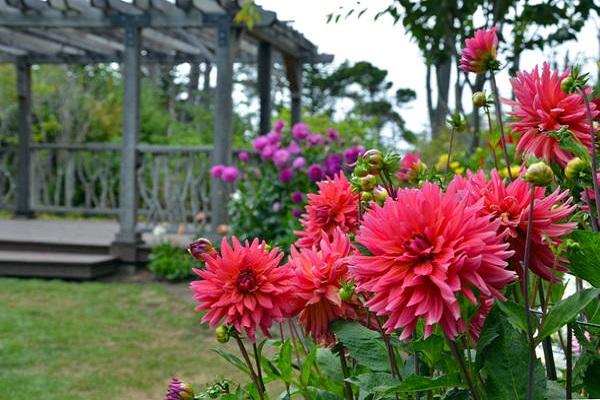
Features of cultivation in different regions
In different climatic zones, dahlias begin to be planted in proportion to the local calendar. Roughly it is customary to plant the plant in May, but in cold regions, in the Urals and Siberia, this period shifts to June.
After planting, dahlias need constant positive temperature, humidity and sunlight.
In the absence of one of these factors, the formation of the trunk, buds, leaves, and inflorescences of a plant occurs with a delay, and sometimes even slows down altogether.

